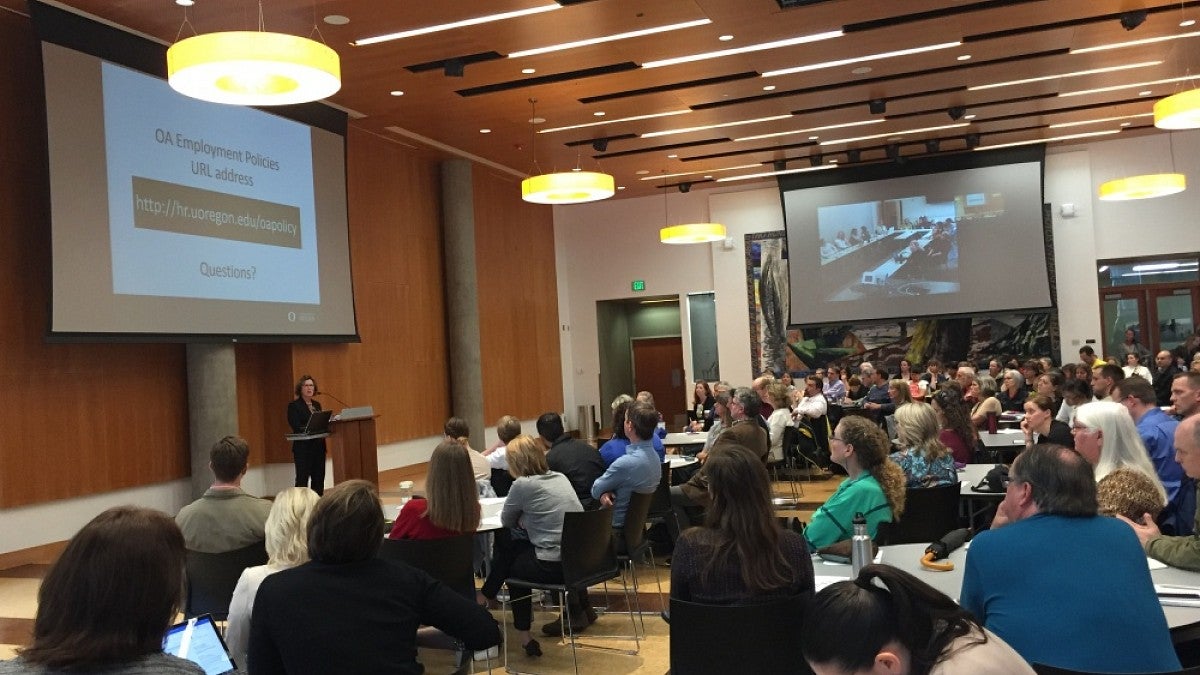The UO’s 1,400 officers of administration, or OAs, are a step closer to having a set of human resources policies and compensation information customized for their particular employment situation and practices.
Human resources leadership provided information about a series of OA-focused initiatives at the Officers of Administration Council’s final meeting of the academic year at the Ford Alumni Center on May 26. The presentation included updates on OA policy development, the OA compensation project and the new talent management system.
Nancy Resnick, the chief human resources officer, said the OA work is part of a comprehensive project they call the year of transformation, designed to build and strengthen HR systems and processes that impact all employee groups across campus.
“The OA projects stem from needs expressed by OAs,” Resnick said. “They reflect the university’s goal to establish specific guidelines for OA employment practices, particularly those that help us recruit, reward and retain our employees.”
In 2014, the OA Council embarked on a listening tour following the findings of a white paper written by an OA Council subcommittee and identified a series of concerns they shared with the university.
“Unlike other employee groups, OAs do not currently have university-established employment policies and procedures and compensation structures,” said Teri Rowe, an OA council representative.
Kaia Rogers, director of HR programs and services, gave an update on the OA compensation project. The project is designed to give more clarity and consistency to OA compensation decisions. She explained they analyzed OA position descriptions and developed compensation structures that account for the broad range of OA positions and salary ranges.
Ninety-five percent of OA employees fall into a structure that includes 15 bands of salary ranges. These ranges are based on national pay averages and were determined by looking at market pay using a variety of comparators, including higher education and general industry. The analysis found the vast majority of OA positions fall within competitive market rates. Approximately 5 percent fall below and 3 percent are above the ranges.
In the next 60 days, OAs will learn where they fall into the job framework and how the university will handle the small amount of salaries that fall below the compensation ranges. Rogers acknowledged employees are likely eager to learn where they fall on the structure, and if their compensation will change.
“Senior leadership is currently evaluating when and how to bring those below the range within range, and, as we have said from the start, anyone above the maximum will not receive a salary decrease,” Rogers said.
“This project is a journey, and there is still more work to be done,” she said. “We want to share the information we do have with the understanding that we may not have all the answers just yet.”
Rogers said the second phase of implementation will focus on finalizing administrative guidelines, administering an appeals process and developing how to maintain the structure, which she expects will happen by December.
During the OA Council presentation, Resnick provided an update on the OA policies being created by a cross-functional policy advisory team. She expects the new proposed policies and procedures for OA employment to be ready for campus review and feedback by the end of summer. They will then go to the university’s Policy Advisory Committee for additional review prior to final approval and implementation.
Nancy Nieraeth, director of talent acquisition and development, also gave an update on the talent management system. She explained the new comprehensive suite of software applications will streamline and optimize talent management for employees, from when they are first recruited and hired through their working career.


